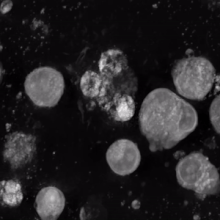This article may be too technical for most readers to understand. (September 2015) |

Megakaryocyte–erythroid progenitor cells (MEPs), among other blood cells, are generated as a result of hematopoiesis, which occurs in the bone marrow. Hematopoietic stem cells (HSC) can differentiate into one of two progenitor cells: the common lymphoid progenitor and the common myeloid progenitor. MEPs derive from the common myeloid progenitor lineage.[1] Megakaryocyte–erythroid progenitor cells must commit to becoming either platelet-producing megakaryocytes via megakaryopoiesis or erythrocyte-producing erythroblasts via erythropoiesis.[2][3] Most of the blood cells produced in the bone marrow during hematopoiesis come from megakaryocyte–erythroid progenitor cells.[4]

References
- ^ Xavier-Ferrucio, Juliana; Krause, Diane S. (2018-08-01). "Concise Review: Bipotent Megakaryocytic-Erythroid Progenitors: Concepts and Controversies". Stem Cells. 36 (8): 1138–1145. doi:10.1002/stem.2834. ISSN 1066-5099. PMC 6105498. PMID 29658164.
- ^ Shin, Eunju; Jeong, Jong-Gwan; Chung, Hyunmin; Jung, Haiyoung; Park, Charny; Yoon, Suk Ran; Kim, Tae-Don; Lee, Seung Jin; Choi, Inpyo; Noh, Ji-Yoon (2020-07-12). "The Gata1low murine megakaryocyte–erythroid progenitor cells expand robustly and alter differentiation potential". Biochemical and Biophysical Research Communications. 528 (1): 46–53. doi:10.1016/j.bbrc.2020.04.143. ISSN 0006-291X. PMID 32456797. S2CID 218911834.
- ^ Soares-da-Silva, Francisca; Freyer, Laina; Elsaid, Ramy; Burlen-Defranoux, Odile; Iturri, Lorea; Sismeiro, Odile; Pinto-do-Ó, Perpétua; Gomez-Perdiguero, Elisa; Cumano, Ana (2021-04-05). "Yolk sac, but not hematopoietic stem cell–derived progenitors, sustain erythropoiesis throughout murine embryonic life". Journal of Experimental Medicine. 218 (4): e20201729. doi:10.1084/jem.20201729. ISSN 0022-1007. PMC 7879581. PMID 33566111.
- ^ Psaila, Bethan; Mead, Adam J. (2019-03-28). "Single-cell approaches reveal novel cellular pathways for megakaryocyte and erythroid differentiation". Blood. 133 (13): 1427–1435. doi:10.1182/blood-2018-11-835371. ISSN 0006-4971. PMC 6443046. PMID 30728145.








